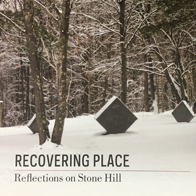Mark C. Taylor is Professor Emeritus at Williams College and Professor of Religion at Columbia University. He has written extensively on subjects ranging from religion, philosophy, and literature to art, architecture, technology, and financial markets. More recently, he has started translating his philosophical ideas into works of art.

July 4–October 10, 2016
cow skull
Cow skull
Unearthed from Galusha Farm, Williamstown, Massachusetts
Lent by Mark C. Taylor
TRANSCRIPT:
Bones are what remain—what remain of the remains. You cannot know your place in the world until you know where your bones will remain, or not remain, after you are no longer. Even when bodies are consumed in sacrificial fires and funeral pyres, bones, or their fragments, are left over.
Bones embody a disturbing coincidence of the personal and the impersonal. Nothing is closer to us than our bones. Indeed, bones are the very substance of our being; for those who know how to read them, bones tell stories of the lives they once supported. In this way, bones—animal and human bones—are the shadow of death in life. Stare at the skull of a cow, a sacred cow that gives the milk that nourishes life, and you see the impending death. Gaze through the skin of your beloved and you see a skull in which your own death is reflected.
For all their individuality and idiosyncrasy, there is something anonymous about bones. They are beautiful, perhaps even sublime; their shapes and contours are as carefully crafted as the most precious works of art. Bones recall the life they once bore and memorialize the universal unknown that lies ahead. It is not the mere cessation of life, but its forgetting that renders death final. Bones prefigure the nothingness awaiting all of us. The dread of the void does not, however, diminish the beauty of bones; it renders it all the more poignant. Like intricate designs etched on stones lying on a hill exposed to wind, rain, fire, and ice, bones reveal a beauty far more vast than any conceived by human invention.
Place matters—truly matters—not only for time, but also for eternity. My bones will remain as close to this place as possible: 1.4 miles south of Stone Hill in a small cemetery, beside a bend in the Green River, near the foot of Mount Greylock, at which Herman Melville gazed while writing Moby Dick.
Recovering Place: Reflecting on Stone Hill
By Mark C. Taylor
An illustrated book chronicling the land art and sculptures created by Mark C. Taylor at his home in the Berkshire hills, echoing themes found in the exhibition. Supported in part by Herbert A. Allen, Jr. and the Clark Art Institute and published by Columbia University Press. Call the Museum Store at 413 458 0520 to order.


